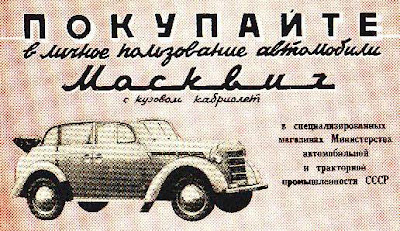 |
| The first Moskvich was built on an assembly line seized from Germany. |
Moskvitch, or Москвич in Russian Cyrillic script, means, you guessed it, a resident (literally "son") of Moscow. The English translation is Muscovite.
Moskvich – no "t" – means a car built in a factory near the Moskva River in southeast Moscow. Some people, by the way, insist on including the extra letter in describing the car company, but that's not the spelling the automaker used in export model badging or sales literature.
Name aside, the factory's first vehicles were the offspring of Detroit, not Moscow. In 1929 the plant, then called KIM (for Communist Youth International, and please don't ask me for the Cyrillic translation), opened to assemble Ford Model A cars and Model AA trucks from kits supplied by the American manufacturer.
Later it was assigned to produce Russian cars, these ones from fellow Soviet automaker GAZ, but it wasn't until a decade after it opened that the Moscow factory was given its own models to build, the KIM 10-50 two-door sedan and 10-51 convertible. Both were based on the British Ford Prefect.
Even as the assembly line cranked to life in 1940, however, factory officials learned that Soviet Premier Joseph Stalin thought the Prefect both dowdy and impractical. Stalin ordered the development of a sleeker four-door model more like the Opel Kadett from Germany, the Soviet's non-aggression pact partner at the start of the Second World War. It should be lower, the factory was told, with headlamps incorporated into the body, and without running boards.
 |
| Generation 2: 588,000 produced. |
The first cars bearing the Moskvich name arrived after Germany's defeat. But while the brand was new, the vehicles were once again based on an existing model – that same Kadett with which Stalin was so taken before the war. As part of reparations the Soviets seized an entire Opel assembly line in the German city of Rüsselsheim and carted it back to the Moscow complex, now called MZMA (Moskovsky Zavod Malolitrazhnykh Avtomobiley).
Debuting as the M-400, the Moskvich version of the Kadett would have a long run, with nearly 250,000 produced as the Soviet Union resumed its war-interrupted industrialization drive. A successor model arrived in 1956 with new body and chassis, though initially still using the 400's flathead four-cylinder engine. Between 1956 and 1965, some 588,000 variants of the second-generation Moskvich – sedans, station wagons, even some jacked-up four-wheel-drive versions – came out of the Moscow factory.
Given Russia's still low rates of vehicle ownership, the 400-series and the series that followed were as close as the country could get to a "people's car." Some would be exported to Soviet satellite nations and trading partners such as Finland. But it was the model that arrived next that would make the Moskvich name known even on the far side of the globe.
Advertisement and factory drawings from sovavto.net